DRC Part 2: Into the heart of the jungle
The Kasai River flows like a natural border separating the green grass-covered hills from the equatorial rainforest. I crossed it in a pirogue and arrived to Ilebo, an important river harbor and the end station of the railway that goes all the way to Lubumbashi. I stayed here for a few days to regain energy and stock up on food supplies that I would need on the upcoming route.
Leaving Ilebo, the road became better than in a long time, but it wouldn’t last long. When I reached Domiongo, I took a smaller road heading north towards the Kasai-Oriental province. From this point, it would take one month until I got cell phone coverage again. Already after a few kilometers, the road was badly eroded and I realized that it must have been many years since cars or trucks were able to pass here. Shortly thereafter, the “road” turned into something that is better described as a trail. On the way, I saw a beautifully colored viper that had already been killed by someone. A deadly beauty though, a guy told me that you’re dead within one hour if you get bitten:
Very few of these days were flat, but I got used to the slow going and the constant rolling hills where the trail sometimes was slippery. In the beginning I was complaining for myself but you realize there’s no point in doing so, and always when I met another cyclist walking with his single speed bike and carrying a lot more load than me, I got reminded about the daily life of these people. One day I was accompanied by François, a young boy who was on his way back home after having been to the market selling palm oil that his family had produced. I camped outside his family’s house and was given very exotic and spiky caterpillars for dinner. I couldn’t see anything because we ate in the dark, and the first thing I did was to get my tongue pierced by one of the thorns. Despite being tricky to eat, it tasted delicious and the meat was as white and as tasty as lobster meat!
On the southern bank of the Sankuru River, I met a village chief who was wearing traditional accessories. He had a green stone necklace and cowrie-shells in his hair. I was warmly received and generously given palm wine and food. The kids here had never seen a white person before, and at first, they thought I was an albino. Actually, in that particular village, a young albino boy came running towards me and gave me a hug and it felt like he experienced some kind of connection because of our color, it was touching!
Being surrounded by a growing density of vegetation and facing the beginning of the rainy season, I stopped spending nights in the bush. Instead, just like in this village, I started asking for the “chef du village” who usually let me put the tent inside his house. Since most people in these places travel by foot or bicycle, villagers are used to strangers asking for a roof over their head. After having been given a bucket of water to shower with, I often shared a dinner with the chief consisting of “schkwang” (cassava bread) or luko/fufu (cassava and/or corn flour mixed and pounded together into a more slimy dough) accompanied by smoked bush meat, smoked fish or caterpillars.
As I advanced further and further into the country, the tribes seemed to become more culturally rich and more different from what I had seen before. Some women in the Kasai-Oriental province would drop down to their knees, take my hands in theirs and bowing their head when greeting me. I always felt embarrased when this happened. Some of the elders had facial scarifications (nothing compared to Nigeria though). One night when conversing with a family over dinner, I asked if they had any old things that they had inherited from their ancestors. They smiled and said yes and sent some children to get them. I was shown a traditional drum, pottery, an old clay pipe, raffia clothes, half a skull from a gorilla and finally how to make traditional body paint by rubbing two pieces from a special tree against each other and adding some water. I can’t believe I’d never asked this before, it was very interesting to see!
In the bigger villages that had small shops, I could barely find anything edible to buy. No biscuits, no sardines. The otherwise fairly common roadside “restaurants” having a few pots on display were absent as well. Instead I started to ask around if someone could cook for me and if I could buy home-grown rice, or fruit whenever there were any ripe varieties available. One day I had dried caterpillar with cassava bread for breakfast, and the following lunch consisted of only boiled rice with palm oil. In fact, I felt a bit worried when I realized that I wouldn’t be able to find anything to buy. But the warm hospitality I encountered, except for the initial begging, made me less worried about it. Actually it was an exciting and liberating feeling when you realized that you had to put yourself in the hands of these people, otherwise I wouldn’t be able to eat.
However, as hospitality increased, so did corruption. In every major village, every river crossing and every province border, there were DGM-personnel (immigrations) waiting for me that always asked for or demanded something (gifts, money etc.). One time, an old “security agent” demanded money from me, but I happened to have a well-educated and bold young bishop by my side, who took my party and accused him of being corrupt. After having argued for half an hour and claiming it to be his right to take money from white people, he gave up. The knowledge of the immigration people was sometimes ridiculous. A couple of quotes:
– “It doesn’t say in your passport that you are a tourist”
– “Everything is in order, your visa expires in 2018” (that’s the expiry date of my passport, 4 years from now)
One time a drunken immigration officer even confiscated my passport and left the village with it (hoping for a bribe of course), only to return the following morning felling ashamed of what he did due to pressure from the villagers who didn’t like to see me badly treated.
But this was not the worst such scenario that happened to me. When I came to Dekese, I met an immigration chief that was worse and more persistent than any corrupt official I had ever met before. I got escorted to his office (an old, rough and bombed out colonial building) by one of his younger staff that had been waiting for me at the river (word had travelled ahead of me that a white man was coming). The chief welcomed me wearing a white tank top and oversized light blue jeans, sitting in front of the house at a cloth-covered table with and a jug of water, with his two wives sitting on a woven mat on the grass next to him. He looked dead serious, but his hard-looking features broke into a fake smile when he gestured to me to sit down. He acted extremely superior and calm, on the verge to being scary in his behavior. Instead of making the mandatory registration, he put my passport in his pocket and told me that I must surely need a good rest and that the formalities could as well wait until tomorrow morning. I kindly asked to get it done now since I wanted to leave early the following day, but he said that the guy with the forms had already left the office.
The following morning was a nightmare and I got so tired of this corrupted country that I actually considered taking a bush plane to get out of there and fly back to Kinshasa. But as always, I was stubborn and didn’t give up and continued my ignorance towards their money-seeking hints. It started with another inspector who in ridiculous detail went through and filled in the form with me, explaining each field two times, even if it was obvious what for example “name of your father” meant. Then a “security agent” appeared and slowly started to copy the form that I had just completed. Then, a third man from another DGM office enters and the three starts working with other things and leave me sitting on a chair staring into the wall. I don’t know how much time that passed before they made a new move. Suddenly, the chief who I met yesterday that took my passport entered the office. Completely outrageous, he started yelling at a colleague who had not tucked his shirt into his pants. I saw the man squint with his eyes and getting covered by saliva, before running towards the door. Then I got questions about going nearby a national park and that I need a permit to be in the area. I was told that I had to return and pass by the provincial capital, otherwise I was not allowed to come here. I also got questions about the issuing of my visa etc. etc. I refused to accept any of these silly remarks and again, a long time passed without anyone proceeding with me. They even said that I have to pay a phone call via satellite to their provincial head office to verify a few things with their superiors. And so the game continued. A new man walks in claiming to be responsible for the tourism ministry. I almost laughed. It was many years ago this place saw a tourist. He handed me a document with different tourist related taxes and claimed that visiting the area and taking photos involved a fee. I read through the document and had to explain to him that the tourism related taxes were for Congolese people who wanted to work with tourism – not for me. He was clearly disappointed and pearls of sweat started to form on his forehead. The funny thing in this corruption carousel is that people try to look serious but are in fact very nervous. They sweat, shiver and their voices start to crack a bit. Sometimes it happens to me too, since the situation is tense and the game very sensitive to verbal mistakes. Anyway, all of a sudden another man passed by and the atmosphere changed instantly for a reason I never understood. They start denying all accusations and that they had been asking me for money. At last, after five hours (!), I felt things coming to an end and the office chief sloppily shook my hand while looking the other way. The inspector took my hand too, squeezed it hard while staring into my eyes and said “le monde est petit” meaning “the world is small”. Was he threatening me? What a mess. I felt like renaming DRC to Democratic Republic of Corruption.
When I finally left Dekese, I was rewarded by great cycling and lovely scenery that I tried to focus on instead of thinking about what had happened earlier that day.
The only means of transport on these trails are bicycles and motorbikes. But given that people have no money and petrol here can cost as much as $5 per liter, motorbikes are rare and the children run after them just like they run after me. Instead, all goods are brought in with bicycle and of course boats when there’s a river nearby. Things like Coca-Cola or beer is nowhere to be found here. One day I met a group of five bicycles transporting smoked bush meat, each load being 200-300 kg. It’s astonishing that it’s even possible, given the road conditions and the distances that these merchants travel (500 km’s or more is not uncommon). I was later told that these guys sometimes carry ivory hidden inside the huge loads. The most remarkable bicycle load I saw was one that in addition to the many sacks stacked on the frame had two 1.5 m long and alive crocodiles tied to each side of it!
Because of the disastrous infrastructure and difficulty to transport goods, almost nothing can be bought here, which also means that very few things are sold, simply because there is little money around. What people buy once they have money is mainly three things: soap, salt and clothes. Instead, they live completely off the nature, and even so (to my big surprise), not at all efficiently. For example, they could easily have planted a lot more fruit trees or variation in crops, but they don’t. The same goes with the universal staple crop cassava, there’s often just enough to feed the family, nothing more. I think it’s hard to see if people suffer from malnutrition, but in some of these villages I saw a lot of sick kids with swollen abdomens, swollen faces and missing hair – all symptoms of protein malnutrition and kwashiorkor.
I asked many of the elders in the villages I passed and they told me I was the second tourist to ever have passed here. The other one had also, not surprisingly, been on a bicycle. You notice that most people have never seen a white person. They stare at you in a different way, and it has happened that people run after me for several kilometers (!). The kids touch and poke you. Sometimes, when standing in the middle of a crowd of kids, apart from the tangible heat that radiates from their active bodies, you can feel fingers poking into your thighs to kind of check if you’re real. One time, I stopped outside of a small school and spoke to the teacher, with a big group of kids surrounding us. I asked her if they had any questions for me. They shook their heads. There must be something that they would like to know, I said. Then I could hear whispers from the crowd, and the teacher told me that they wanted to know how I felt, they wanted to touch me. So I reached out and extended my arms and got completely covered by small hands stroking me followed by laughter, haha!
Let me introduce you to the most useful tree in the tropics: the raffia palm. The fibrous underside of the leaves can be removed and dried and made into rope, snares and traditional clothes. The whole leaf is used for making roofs, baskets, mats and rucksacks. The stem of the leaf is used for making brushes. The branches are used for building houses and furniture. The sweet sap is extracted to make juice or a slightly alcoholic drink called palm wine. And the most fascinating thing of all, when everything of the above has been made and there’s just a seemingly useless trunk left, the palm tree’s final use is to become a larvae factory! The trunk is cut clean, lightly burned and then punctured with holes that are then patched with leaves. Then you just wait for a month, and after cutting down the palm you can find 100-1,000 palm grubs (beetle larvae) that are high in fat and protein. They taste kind of like butter and bacon and I once cooked them myself together with oil palm fruit, lemon leaves and garlic, delicious!
I cycled all the way to the supposedly most centrally located village of the DRC called Loto, where I had been told I could find petrol and basic food. Here, I met a young and friendly bishop called Justin working at the Catholic mission, so I took a much needed rest day. He invited me for dinner and gave me a guided tour on the premises, where during the day plenty of young boys arrived since this was the start of the semester for the next generation of Catholic priests. Justin gave me spaghetti and sugar that I couldn’t find in the village, but I was able to buy some sardines at least. I didn’t find any powder milk either, but I got some rice from a family who were selling their own produce.
Leaving Loto behind, I backtracked 15 kilometers and entered an even smaller trail heading north towards the so called Monkoto Corridor that splits the Salonga National Park into two parts. The Salonga National Park is Africa’s largest rainforest reserve covering about 36,000 km2 and it was declared a UNESCO World Heritage Site in 1984. This park contains a sub-species of the chimpanzee called bonobo, which has been determined to be humans’ closest relative. For a long time, I had been looking at satellite photos of the area and seen that there was a road running south through the corridor, but that there was a part missing that would connect the Equateur province with Kasai-Oriental. I told myself that there must be something, but I was met by more skepticism the closer I got. However, when now being on the final road leading to what could be a dead end, the villagers said that there was a footpath through the jungle that would take three days but it would be impossible to cycle there because of all the fallen trees and thick vegetation.
The attention I got on this section was more than I had ever seen before. It turned out that it was over 20 years ago the last foreigner (a Belgian missionary) was here and 25 years ago since the last vehicle passed – wow! All children, teenagers and young adults had never seen a white person before, and most adults had of course never spoken to one. In every village, every house and every person, I was met by extreme curiosity. As always, it feels kind of charming, but it gets tiring in the long run. I tried not to show it though, because it is of course a big happening for these people if they get a chance to look at and speak to a white man. In many villages I had a hundred people running after me shouting to me to stop.
The village in the end of this trail is called Dibaya. From here, I got a final confirmation that it was possible to reach Equateur and the Monkoto corridor using a footpath. But I would need help, I could not do it alone. So I found three people that were willing to help me in exchange for money. Two would carry my panniers and the third one and I would help each other with the bike and the rest of the equipment. I removed the pedals to avoid them getting stuck in bushes and lianas, rearranged my luggage a bit, pitched my tent and started to cook rice. While sitting inside my tent to avoid the mosquitoes, people were standing outside with flashlights looking at me. I’ve given up telling people to leave until at least I’m about to eat, when usually one of the elders ask everyone to leave me alone anyway. This attention is mentally demanding and by far the toughest thing about travelling here. While the villagers stayed up half the night playing drums and dancing, I lied down in my tent longing for things like anonymity, tranquility, peacefulness, comfort, civilization, food, intimacy, recognition and affinity. But at the same time, I felt so grateful and lucky to be here.
We started walking on the footpath at 7am. I quickly realized that it would have been almost impossible to do this myself and felt bad for having told the people something like: “how hard can it be…”. In some places, the path was covered with fallen trees, ranging from small ones to 1.5 m wide trunks. It was narrow and brushy with different types of jungle vegetation. The first day, we walked for maybe 8-9 hours but covered only around 20 km’s. We had cassava bread with caiman meat for lunch. I had never eaten it before but it was very tasty, kind of like a mix between pork and turkey. We passed a small settlement on the way and the elders said that it was the first time ever that a foreigner passed here.
When I woke up for the second walking day my body already ached. Mainly from lifting the bike up and down and using new muscles, but also from insect bites that I had collected during the past weeks. My hips were aching too, and my shoes were almost worn out so I was constantly walking in dirt and mud. We didn’t do much more than walking that day apart from a few breaks. Along the path, we encountered a group of people coming from the opposite direction and they got very surprised when they saw me.
There were some women in the group that accompanied us that went to catch fish for dinner in a small stream. They cooked them in fresh leaves in the open fire together with wild herbs, including a jungle plant tasting garlic. What a delicious meal! I fell asleep that night thinking that I would probably never visit a more remote place in the rest of my life. Leaving this place by land trying to get to a developed city as fast as possible, even when having access to a motorbike at either end of the path, would take at least a week. A scary but at the same time exciting feeling of remoteness.
The third day was the toughest one. By mid-day, the rain began to fall but we didn’t have any other option than to continue. Ear deafening lightning hit trees in our vicinity so close that we could feel the smell of something burnt. It’s surprising how cold you can get by walking around in wet clothes during tropical showers. I fantasized about being back home having picked mushrooms and now walking towards where we had left the car, and then in detail what I would do once I got back to the house. The feeling of hot water running over my cold body put a big smile on my face and gave me extra energy to push on. I also fantasized about food the way I often do: fresh salad with olive oil and lemon juice, cured salmon, dill potatoes, asparagus with butter, waffles, grilled sausage, lingonberry juice, a glass of cold milk, olives, spaghetti Bolognese, tacos, dill chips, chips dip, cucumber, béarnaise sauce, hollandaise sauce, fresh shrimps, aioli, rose hip juice, blueberries, raspberry, strawberries with cream and sugar, pickled herring, grilled meat, gingerbread biscuits, ceviche, pizza, hamburger, goat cheese with root beets, apples, pears, apple pie, eating cold fruit in a hot shower.
My body was shivering when we finally, after having covered around 60 km’s on foot, reached the village Ngongo in the Equateur province. On top of that, I had my first encounter with FARDC, the DRC military, and the corruption carousel started spinning again. After a series of questions, the commander told me that I should give him my phone but got very upset after my refusal and then insisted on putting me in prison (a deep hole in the ground covered by a thatched roof). It was unclear if this was because he didn’t know what a tourist really was or because I didn’t give him anything. By the way, the man introduced himself as something that would translate into “danger of death”.
I looked quite beat up after the three-day long walk. My arms and ankles had been cut by sharp liana and other undergrowth trying to regain the area of the footpath. The small trees and bushes that had been cleared next to the path were all cut about 20 centimeters above ground which meant that you constantly stumbled on these hidden obstacles. I slept miserably, often waking up and starting a scratching session that lasted for hours before drifting off into sleep again. Mosquitos, horseflies, bees, no-see-uhm’s, no-name-uhm’s and of course the scratching itself had all left traces on my body and didn’t seem like healing in the humid air. Having feet covered with blisters, watering and infected wounds and bruises, I walked barefoot in swamps and bathed in streams and ponds like I normally would, not bothering anymore about whatever bacteria or fever might hide in the murky waters. Every morning I woke up being surprised that I felt fine and hadn’t caught any tropical disease. It’s quite hard to realize, but if you seriously would need an urgent treatment, it would take a week to get there. Yet this is the reality for anyone living in this region. But I never worried about this, I was probably more concerned about not choking myself to death with the huge amounts of sticky cassava bread that became part of my daily diet.
Since this area is situated in the middle of the immense Salonga park, I had a high anticipation on spotting wildlife. But I got disappointed. We only saw a few elephant tracks and monkeys, but that was all. I found far more villages and people in this area than I had expected, and bush meat is a big business and a big source of protein for the people living here. The area is also said to be heavily poached for illegal bush meat, and even ivory, outside as well as inside the national park.
Leaving Ngongo, I could continue cycling through the corridor but it was not without any problems – the trail was narrow and many fallen trees made progress slow.
I spent the night in a tiny but hard-working settlement called Wangilofeka. Here, blacksmiths were operating a forge where they produced arrows and knives. The forge was made by a trunk where four bellows had been cut out and covered by animal skin, that could be “pumped” using wooden sticks to create the airflow necessary to reach a high temperature in the fire for softening the iron. The arrows heads are attached to the arrows using homemade rope, and the knives to their handles using resin – natural glue. When the blacksmiths wanted to take a break, someone went to pick fresh tobacco leaves that were dried over the fire, grinded in a bowl and put in a homemade clay pipe. After that, coffee was made in the same way, picked around the corner, roasted and then grinded and brewed. Apart from the metal works, these people sold honey and palm oil, also locally collected and produced. Talk about using fresh stuff and living close to nature!
I was surprised to see that people still were hunting with bow and arrow in the DRC. It felt so ancient, but is of course, together with wire traps, the most accessible way of hunting in this remote and poor area. One day I met an old man on the trail, who had come back from hunting in the jungle. When I slowed down to say something I could see that he by reflex reached for the arrows in the quiver hanging over his shoulder, and kept it there until I continued. That was actually a bit scary, I wonder what went through his head! This was not the first time I noticed that people were afraid of me, and later when speaking with some about this, I got a confirmation that indeed many people are afraid of whites, since most of them have only heard about them but never met any.
Since I didn’t have a good experience from my first meeting with FARDC, I tried to ignore their checkpoints and pretending not to notice them. But that was easier said than done. Five hundred meters after I passed Ikandja, a big guy with an AK-47 dancing on his shoulder came flying on a single speed bike screaming at me to stop. I had to turn back for them to take some notes before I was allowed to pass. Later that day, I passed a second FARDC checkpoint where I met Captain Jack. He was nice, but his fellow soldiers were drunk above their necks. They were all wearing red bandanas and doing the robot dance while passing a small baby monkey in between them. It felt like I was watching a movie.
When I finally reached Monkoto and what felt like a milestone, I was physically and mentally weak. I thought I had gotten malaria because all my joints and muscles were aching and I felt feverish. I went to the hospital the following morning but the test turned out negative and the other measurable things were normal. Perhaps it was just my weight that was not because I weighed only 61 kg, which means that I had lost 14 kg since I started the trip. I’d never felt this way before, but I felt miserable and had a lot of homesickness. My ambitious idea to build a raft and descend the rivers was out of the question. I wouldn’t have had the time anyway because I only had a few weeks left on my visa. I had also been thinking about taking a pirogue down the Momboyo River and then cycle through the pygmy areas to Mbandaka where I could take a barge back to Kinshasa, but even this idea didn’t get me too excited right now. Instead, I opted for taking a boat the whole way to Mbandaka and so the waiting began. I spent the days doing absolutely nothing. The foreigners usually working at WWF and other places had all left because of the Ebola outbreak that happened a bit north from here. People were stalking me in the village and kept on begging me for things. The immigration guys also had an eye on me and kept on telling me to pay a registration fee. I spent the days staring into the wall and didn’t want to finish my books because I would need them on the boat trips. I bought some fishing gear but it was too hot and too many insects around the river so I gave up. During these days of constant waiting, I got so bored that I started to study the behavior of the rain. One week after the boat guys had said that they would leave within one week, they still said that they would leave within one week. I had even let a man build a comfortable chair for me for the long boat journeys ahead, but finally I gave up and cycled north towards Boende in search for an airport.
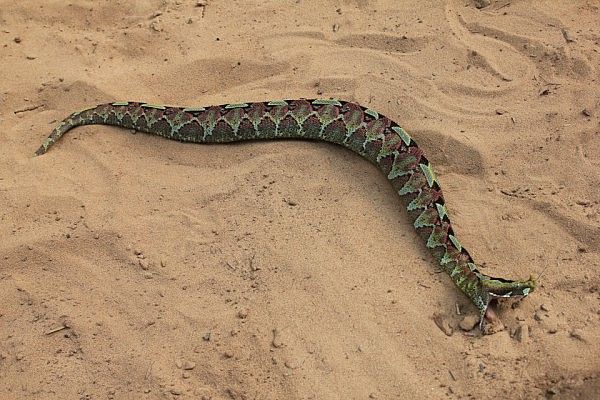

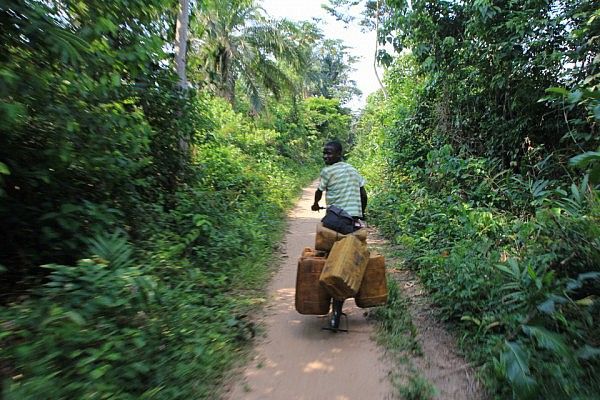

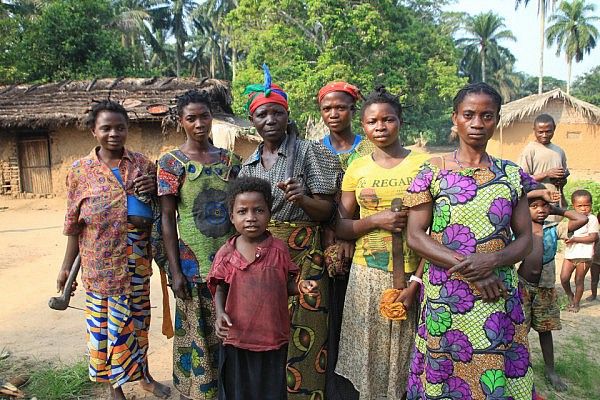

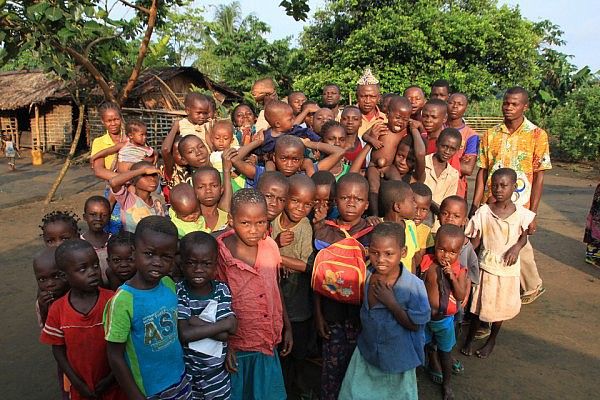


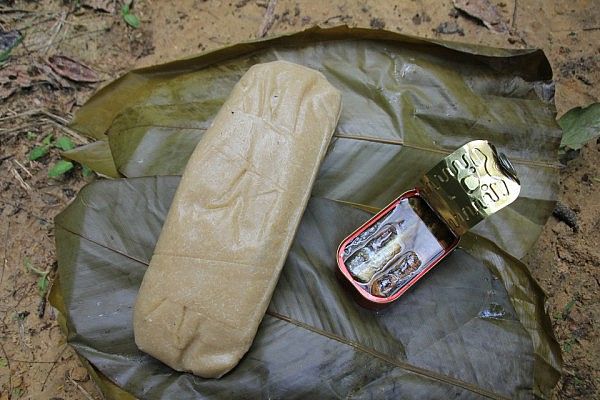
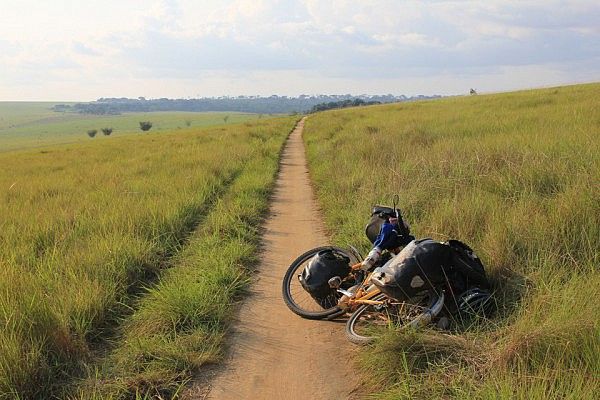




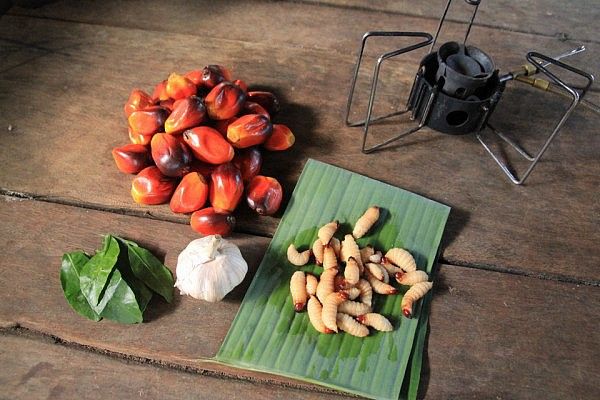
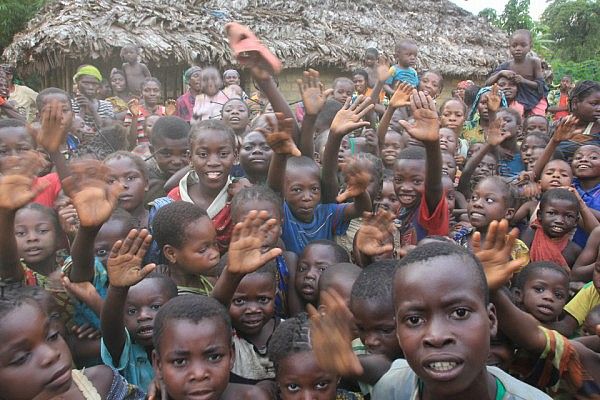
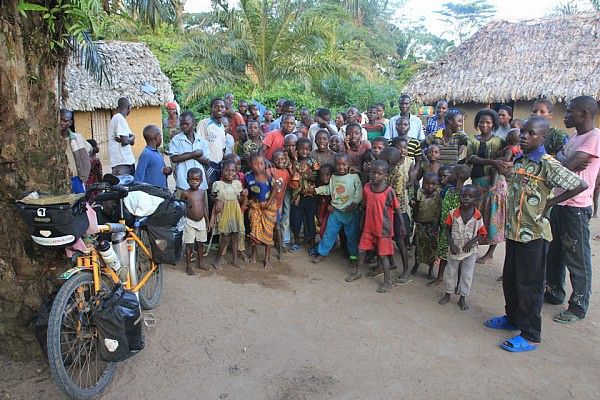









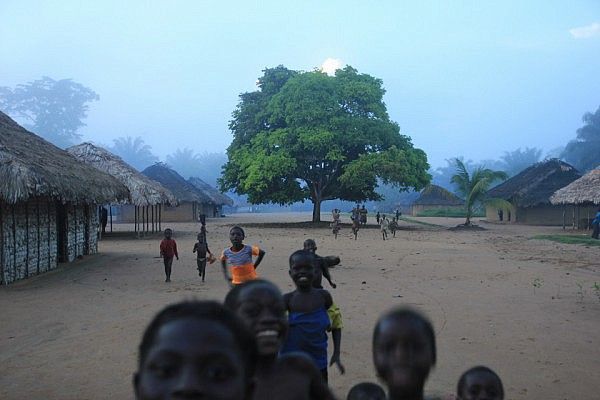




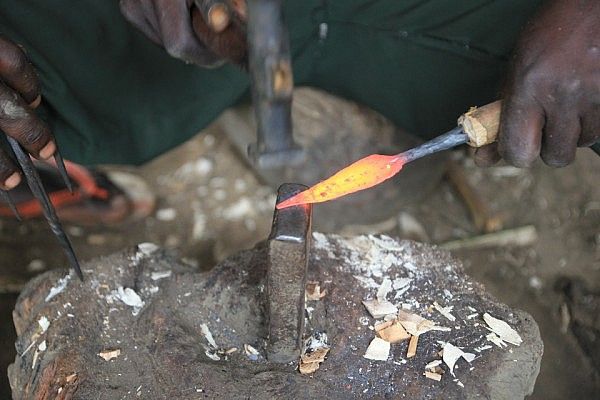
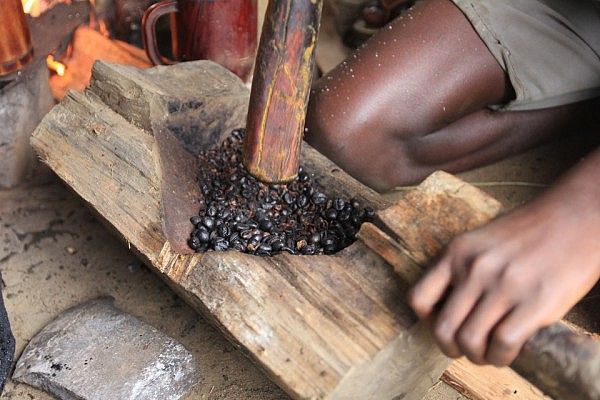

















































































Helt fantastiskt. Respekt! Blev lite ledsen av att läsa följande: “We only saw a few elephant tracks and monkeys, but that was all. I found far more villages and people in this area than I had expected” Snart finns det verkligen ingen vildmark kvar.
Grymt kul att följa din resa Calle och en stor tumme upp för dig. Är mäkta imponerad
you know what puts me off going there … the food
By reading your blog, I might experience 0.01% of what you experience… but even that is amazing and teaches me a lot. These pictures and your stories are worth so much. Thanks!
Jag är så imponerad av dina bedrifter, inga vägar, dåligt med mat och alla korrupta tjänstemän. Du måste ha en otrolig vilja och stort mod. Läser din blogg varje gång och följer med på kartan, spännande och lärorikt.
Även dina bilder håller toppklass.
Hälsningar Per-Inge Björn, Mariefred.
Fantastiskt inlägg – igen!
Calle, du är otrolig, det är ofattbart för en vanlig medelsvensson att ens snudda vid att förstå de strapatser med fysiska och psykiska påkänningar du fått genomgå. Jag är själv ingen duvunge när det gäller resor, började redan i slutet på 50- talet. Men det är en mild västanfläkt mot vad du hittills upplevt. Kan inte göra annat än önska dig lycka till på färden som återstår.
Vilket äventyr. Tack för att vi fick vara med på ett hörn!
Hi, I started to read your blog a few months ago since I got to know it trough Wouter Cocquyt, a belgian guy cycling to Cape Town as well. Ever since, I check out your blog every day and hope for a new update. The waiting never dissapoints me, When I think, this story cannot be beaten anymore, you post an even more great story.
After cycling to Thailand, I got the idea of cycling to Cape Town, your stories are more than inspiring, best blog ever!
Enjoy cycling!
Är så glad att jag efter GP:s artikel om dig inför denna Afrikaresa anmälde mig till att få dina nyhetsbrev. Vad allt har vi inte fått uppleva via dig, helt fantastiskt. Den ena berättelsen mer otrolig än den andra. Är själv inte fysiskt så alert så jag tycker det är så imponerande och glädjande att du klarat allt detta fysiskt och psykiskt. Lycka till i fortsättningen. Ser fram emot nästa mail.
Fantastiskt att läsa om dina upplevelser. Lika intressant varje gång.
Helt otroligt spännande att få läsa dina äventyr!
:)
Såååååå nyfiken på nästa inlägg :) Härligt att följa ditt äventyr!!! Ta hand om dig!
Just amazing. Keep going and tons of luck.
Steen
Like always feels amazing reading it.. luv the way u write it.. almost feel like am actually there.
Be safe, take care and njoy :)
Well done and so well written. Heaps of dejavu moments for me as I have travelled thru DRC a couple of times. 93 hitch hiked overland Ethiopia to Rep of Congo via ‘Zaire’ and 2006 Ghana to Cape Town by motorbike. All the bad and frustrating things aside the most amazing place and so far removed from the western experience you will ever get to see in the central/eastern side of DRC. Gets pretty tiring but hang in there. Next challenge is going to be a visa for Angola but with your determination sure you will find a way. But don’t miss it if possible. Try the coastal route after Luanda. Police/army are a cake run once you get past the DRC border.
All the best and looking forward to your next instalment.
Calle, du är verkligen en författare. Magiskt bra skrivet och så kul att läsa! Kämpa på! KRAM //Lotta